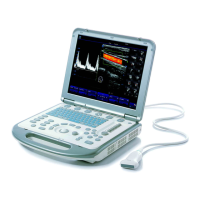Acoustic Output
23-5
23.7 Acoustic Output
23.7.1 Derated Ultrasonic Output Parameters
In order to determine the relevant Ultrasonic Output Parameters, a method is used which
allows for the comparison of ultrasound systems which operate at different frequencies
and are focused at different depths. This approach, called "derating" or "attenuating",
adjusts the acoustic output as measured in a water tank to account for the effect of
ultrasound propagation through tissue. By convention, a specific average intensity
attenuation value is used, which corresponds to a loss of 0.3 dB/cm/MHz. That is, the
intensity of ultrasound will be reduced by 0.3 dB/MHz for every centimeter of travel from
the transducer. This can be expressed by the following equation:
)10/3.0-(
10
zf
wateratten
c
II
××
×=
Where I
atten
is the attenuated intensity, I
water
is the intensity measured in a water tank (at
distance z), fc is the center frequency of the ultrasound wave (as measured in water), and
z is the distance from the transducer. The equation for attenuating pressure values is
similar except that the attenuation coefficient is 0.15 dB/cm/MHz, or one-half the intensity
coefficient. The intensity coefficient is double the pressure coefficient because intensity is
proportional to the square of pressure.
Although the attenuation coefficient chosen, 0.3 dB/cm/MHz, is significantly lower than
any specific solid tissue in the body, this value was chosen to account for fetal
examinations. In early trimester ultrasound fetal examinations, there may be a significant
fluid path between the transducer and the fetus, and the attenuation of fluid is very small.
Therefore the attenuation coefficient was lowered to account for this case.
23.7.2 Differences between Actual and Displayed MI
and TI
In operation, the system will display to the operator the Acoustic Output Parameters
Thermal Index, TI, or Mechanical Index, MI (or sometimes both parameters
simultaneously). These parameters were developed as general indicators of risk from
either thermal or mechanical action of the ultrasound wave. They serve to indicate to the
operator whether a particular setting of the system increases or decreases the possibility
of Thermal or Mechanical effect. More specifically, they were designed to assist in the
implementation of the ALARA principle. As an operator changes a given system control,
the potential effect of the change in output will be indicated. However, the Thermal Index
is not the same as temperature rise in the body, for several reasons. First of all, in order to
provide a single display index to you, a number of simplifying assumptions had to be
made. The biggest assumption was the use of the attenuating formula described above,
which is much lower than the actual value for most tissues within the body. Scanning
through muscle or organ tissue, for example, will produce much higher attenuation
than0.3 dB/cm/MHz. There were also significant simplifications made for the thermal
properties of tissue. Therefore, scanning through highly perfused tissue, such as the
heart or vasculature, will produce significantly less thermal effect than that suggested by
the Thermal Index.
Similarly, the Mechanical Index was derived to indicate the relative possibility of
mechanical (cavitation) effects. The MI is based on the derated peak-rarefactional
pressure and the center frequency of the ultrasound wave. The actual peak-rarefactional
pressure is affected by the actual attenuation caused by tissue in the path between the

